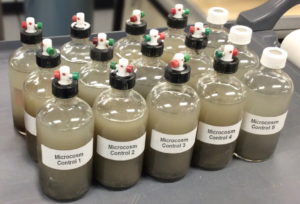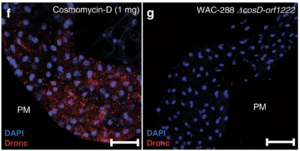
Microblog
Mobilizing Twitter for COVID-19 surveillance
 COVID-19 hardly needs an introduction. You’d be hard-pressed to find someone completely unaffected by, let alone unaware of the large-scale social, economic, and of course healthcare-related disruptions caused by the novel coronavirus SARS-CoV-2. Rapid human-to-human transmission, alarmingly by presymptomatic and asymptomatic carriers in community settings, has prompted massive research endeavours devoted to containing its spread. While much of this work has focused on the development of rapid diagnostic tests and vaccines, alternative initiatives at the intersection of infectious disease epidemiology, human geography, and communication technology are instead exploring how our online presence can be leveraged to evaluate and support public health responses.
COVID-19 hardly needs an introduction. You’d be hard-pressed to find someone completely unaffected by, let alone unaware of the large-scale social, economic, and of course healthcare-related disruptions caused by the novel coronavirus SARS-CoV-2. Rapid human-to-human transmission, alarmingly by presymptomatic and asymptomatic carriers in community settings, has prompted massive research endeavours devoted to containing its spread. While much of this work has focused on the development of rapid diagnostic tests and vaccines, alternative initiatives at the intersection of infectious disease epidemiology, human geography, and communication technology are instead exploring how our online presence can be leveraged to evaluate and support public health responses.
In the modern era of widespread global travel, real-time monitoring of human mobility is critical to infectious disease management. Compared to traditional disease surveillance conducted by health authorities, user-generated digital approaches can more readily integrate the relevant geospatial information in a rapid, high-volume, and cost-effective manner (Grantz et al. 2020, Simonsen et al. 2016). Usage of aggregate and (pseudo-)anonymous mobile phone data has been widely proposed (Budd et al. 2020, Grantz et al. 2020, Oliver et al. 2020); similarly, companies like Apple and Google recently released consumer mobility data from mapping services to aid COVID-19 efforts (Apple 2020, Google 2020). In addition, a growing number of tracking apps have been established worldwide. However, privacy protection has been raised as a significant security, ethical, and legal concern (Budd et al. 2020, Sharma and Bashir 2020). In contrast, publicly accessible online social networks such as Twitter with user-defined location tagging and sharing may represent less problematic data sources. Twitter data mining has also previously been applied and validated in the surveillance of diverse viral outbreaks, most commonly for influenza (Al-Garadi et al. 2016).
Notably, collaborating scientists at the nonprofit research institute RTI International, Harvard University, Oxford University and the University of Toronto analyzed geolocated tweets to predict the early spatiotemporal expansion of COVID-19 (Bisanzio et al., 2020). The researchers modelled travel patterns from Wuhan, China– ground zero of the pandemic– by filtering for Twitter users who posted twice on consecutive days from within the city during November to January, then travelled domestically or internationally in the subsequent 30-day period. The resultant destination log was then correlated to data for 8,235 confirmed coronavirus cases as of January 30, 2020. Additionally, the authors incorporated the infectious disease vulnerability index (IDVI), an externally devised metric to assess the outbreak response capacity of exposed countries (Moore et al. 2017).
Of 161 Twitter users meeting the study criteria, 133 traveled to 157 Chinese locations and 60 visited 119 locations in 28 different countries. The most-visited international regions were the US, Thailand, Saudi Arabia and Australia, respectively. 25% of the study cohort also travelled to multiple locales, increasing the potential risk of transmission. Strikingly, nearly 75% of the 54 COVID-19 cases recorded outside China with known geographic coordinates were reported less than 15 km from a city visited by at least one individual. Moreover, case sites were found to be statistically closer to these locations than major Wuhan-connected airports. Based on these results, the study anticipated new cases in nations which had yet to report any but were visited by multiple cohort users; namely, the UK, Saudi Arabia, and Indonesia. Accordingly, an index case with origins related to Chinese travel was reported in the UK immediately after the study’s submission (The Times 2020). Finally, several countries which were visited by the study cohort and received low-to-moderate IDVI scores (<0.7) were also identified as at risk of COVID-19 outbreak.
In conclusion, Bisanzio et al. have shown that geolocated social media data can provide key insights into human movement and associated disease spread. Such analyses could be particularly powerful when combined in multipronged pandemic surveillance strategies. Importantly, effective yet privacy-conscious implementation will require significant and thoughtful collaboration between academic, private, and government stakeholders.
An underlying commonality between social media and COVID-19 is the unprecendented, near-universal roles both have played in restructuring how we experience and communicate in our daily lives. Now, the digital hyper-connectivity afforded by the former might provide the solution to controlling the latter.
Primary Research Article
Bisanzio, D., Kraemer, M. U. G., Bogoch, I. I., Brewer, T., Brownstein, J. S., & Reithinger, R. Use of Twitter social media activity as a proxy for human mobility to predict the spatiotemporal spread of 2019 novel coronavirus at global level. Geospatial Health 15:882 (2020).
Other References
Al-Garadi, M.A., Khan, M.S., Varathan, K.D., Mujtaba, G., Al-Kabsi, A.M. Using online social networks to track a pandemic: A systematic review. J Biomed Inform 62:1-11 (2016).
Apple. Apple makes mobility data available to aid COVID-19 efforts. https://www.apple.com/ca/newsroom/2020/04/apple-makes-mobility-data-available-to-aid-covid-19-efforts/ (2020). Accessed November 3, 2020.
Budd, J., Miller, B.S., Manning, E.M. et al. Digital technologies in the public-health response to COVID-19. Nat Med 26, 1183–1192 (2020).
Google. COVID-19 Community Mobility Reports. https://www.google.com/covid19/mobility/ (2020). Accessed November 3, 2020.
Grantz, K.H., Meredith, H.R., Cummings, D.A.T. et al. The use of mobile phone data to inform analysis of COVID-19 pandemic epidemiology. Nat Commun 11, 4961 (2020).
Moore, M., Gelfeld, B., Okunogbe, A., & Paul, C. Identifying Future Disease Hot Spots: Infectious Disease Vulnerability Index. Rand Health Q 6(3), 5 (2017).
Oliver, N., Lepri, B., Sterly, H. et al. Mobile phone data for informing public health actions across the COVID-19 pandemic life cycle. Sci Adv 6, eabc0764 (2020).
Sharma, T., Bashir, M. Use of apps in the COVID-19 response and the loss of privacy protection. Nat Med 26, 1165–1167 (2020).
Simonsen, L., Gog, J.R., Olson, D., Viboud, C. Infectious Disease Surveillance in the Big Data Era: Towards Faster and Locally Relevant Systems. J Infect Dis 1;214 (2016).
The Times. Hunt for contacts of coronavirus-stricken pair in York. https://www.thetimes.co.uk/article/hunt-for-contacts-of-coronavirus-stricken-pair-in-york-dh363qf8k (2020). Accessed November 4, 2020.

Posted on : 10/11/2020 2:00 PM
Liked this post?
Click the social media icons on the left to share!
Have anything to say? Comment below!



